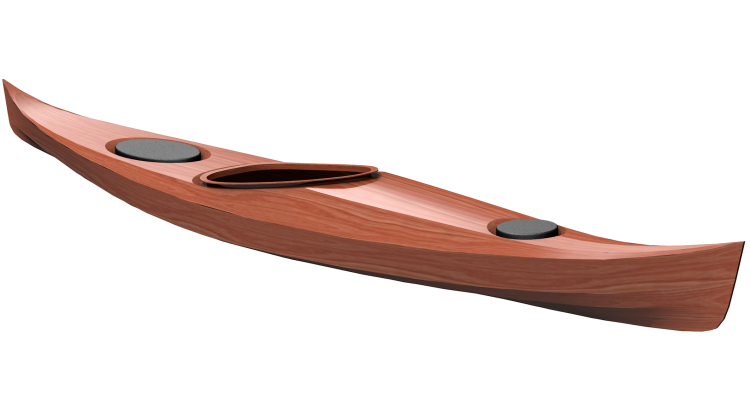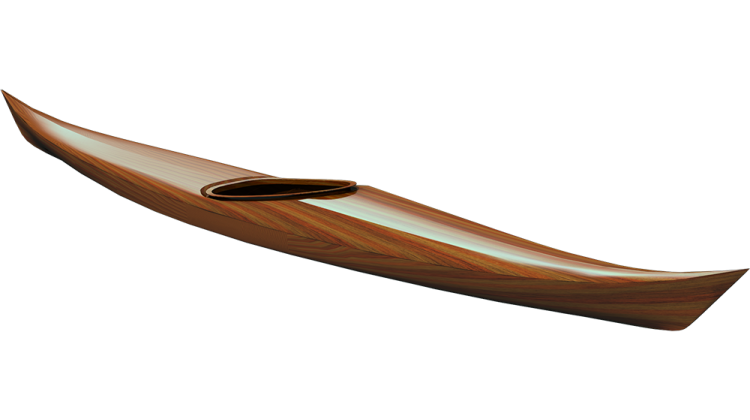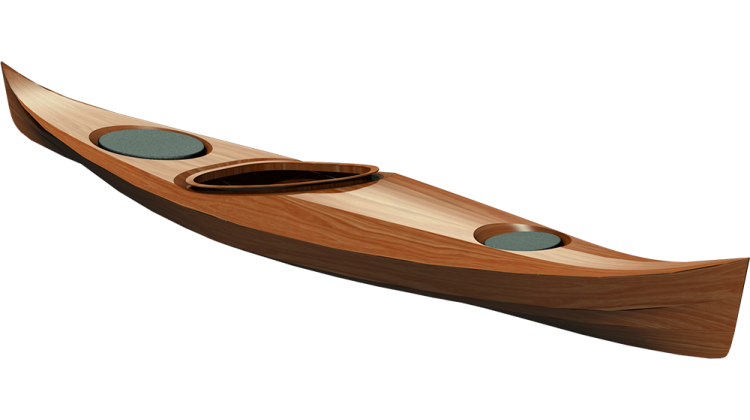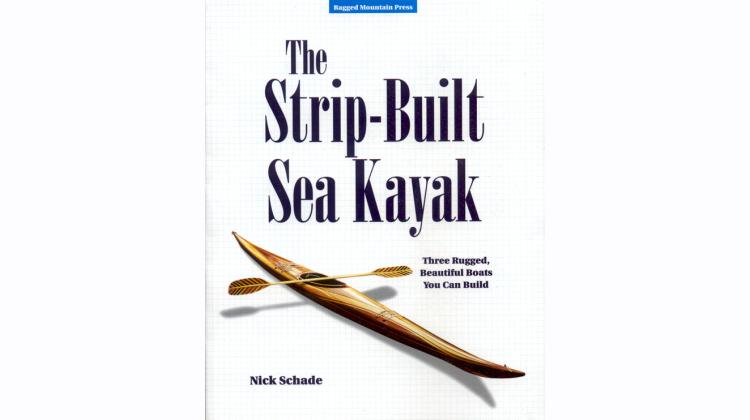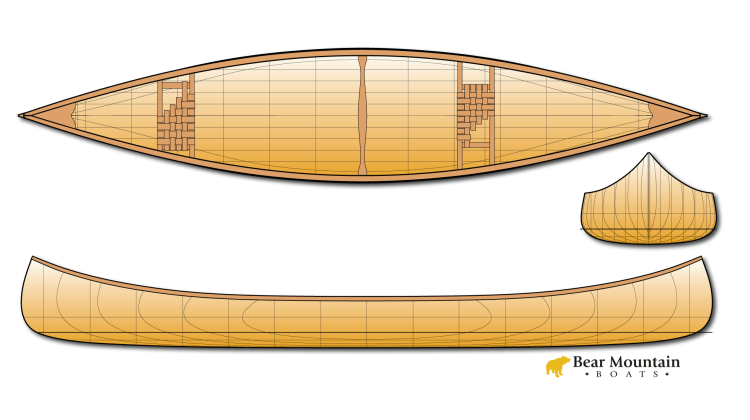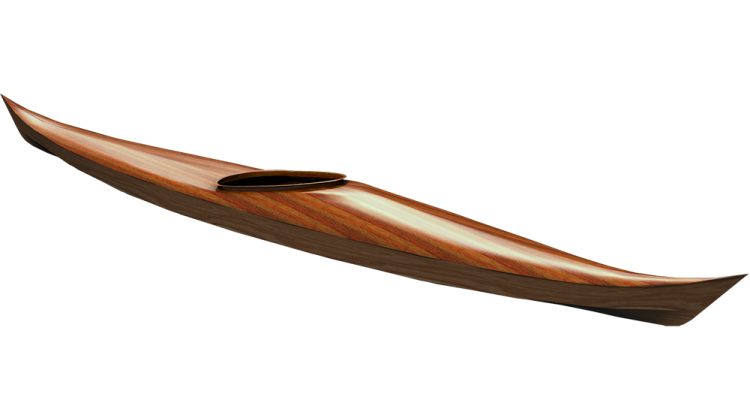Nick Schade, a boat designer and builder, documents the construction of his "Runner" kayak. The video details the design process, focusing on creating a kayak optimized for surfing downwind waves. Schade utilizes strip-plank construction, showcasing the techniques involved in shaping the hull and deck from wood strips. The build highlights his attention to detail and the use of various materials like mahogany, Alaskan yellow cedar, and fiberglass for both aesthetic and structural purposes. Finally, the completed kayak is shown, emphasizing its performance capabilities and elegant design.
Table of Contents
- 0:00 Introduction
- 0:24 Design Goals
- 1:32 Design Details
- 3:50 Building the Forms
- 6:17 Staple-less Strip Planking
- 10:00 Woodworking Techniques
- 15:19 The Router Trick
- 16:55 Deck Strip Planking
- 21:36 Releasing the Hull
- 22:22 Joining Deck and Hull
- 25:35 Deck Accents
- 28:46 Fairing and Sanding
- 31:35 Reinforcing and Fiberglass
- 38:16 Skeg Control Slot
- 40:57 Rudder and Fairleads
- 41:56 Leveling Part Line
- 42:38 Compass Installation
- 44:41 Final Assembly and Finish
- 45:28 Conclusion
Hey, welcome back to the Guillemot Kayaks workshop. I'm Nick Schade, a boat designer and builder.
In this video I build the coolest kayak I've ever built. It's been said the cobbler's kids have no shoes. I don't even have kids, but my personal kayaks needed some love. It's a lot more fun building something new than fixing something old, and since it's been 15 years since I made something for myself, I thought it was time. Many of you know me for making museum worthy kayaks, but I am really more interested in how they perform on the water than what they look like.
That's said, I understand a shiny new kayak is better advertising than a worn out old one, regardless of how it performs. I wanted a nice, new looking kayak and had specific ideas in mind. I've built several microbootlegger sports for customers and I really like the design. It's elegant and distinctive. With a rolled sheer that has the vibe of a 1920s mahogany runabout and handles like a sports car. I really wanted one for myself. However, I don't like building the same thing twice. I'll do it for customers, but it's more interesting if I convince them to order something new.
Since I'm building this kayak for myself, there should be minimal disagreements. I wanted something unique that fit an unfilled niche. Sea kayaks are designed to paddle in open, rough water. I live at the eastern end of Long Island Sound. On the right day a west wind blows down the sound that creates great down wind conditions. The waves are big and steep enough that a fast kayak can catch a ride surfing along faster than you can paddle. While I have fun in my existing designs, I thought a kayak specialized to excel in these conditions would be fantastic.
I started with my microBootlegger Sport. It's about 15 1/2 feet long and 22 inches wide. The nearly plumb bow and stern provide a fast, almost full length water line and share some design cues with surf skis. Long and narrow means speed. I stretched it out and squeezed it in, going to 17 feet long and 20 inches wide. The transitional chine, soft in front, hard in back of the bootlegger sport is already good for lift and edging control while surfing.
Paddling fast requires good ergonomics. I cut away the fore deck sides to allow the paddle stroke to catch in close. A rudder lets you steer at speed, so I shape the stern to hang one and balance the forward profile by squaring the bow. Going from a slight overhang to a "hatchet" style. Punching your bow into the wave ahead creates drag. Added volume up front, added buoyancy to float it to the surface. With the kayak sitting in the wave's pocket, most of the lift is centered behind the cockpit. I move the widest part aft for more lift. The Swede form also keeps the paddle catch area narrow.
After analysis, I shifted volume from the stern to the bow to help lift over waves, I like the resulting Roman nosed foredeck. A sea kayak has hatches. I wanted to make themselves draining. I started with a small front hatch to keep the paddle catch area narrow. But I sacrificed a bit of that slim fore deck to ease gear loading by fitting a larger hatch. After analyzing the center of buoyancy, I balanced the cockpit forward. Finally, I added a day in whiskey hatch and a compass.
I'm calling this kayak "Runner." While, it's very different from its micro bootlegger sport ancestor, you can still see the family resemblance. Runner is sleeker with a more aggressive look. There are a lot of 17 foot sea kayaks out there, but there's nothing like Runner. Honestly I think the design looks awesome. After about a year of design work done, it's time to realize the kayak in my shop. All that design work produced was a 3D shape. To build a strip plank boat I need forms.
My design software sliced up the shape into sections. I'm using leftover strips from earlier builds. The mahogany is an 1/8th inch thick. To support these thin strips I chose of 10 inch form spacing. I deducted the thickness of the strips from the outside of the station so the finished face will match the surface of the design.
My plan for this boat is to use strips I basically had kicking around. I have a bunch of mahogany strips left over from customer projects, and I have some Alaskan yellow cedar here. What I'm thinking of doing is having the top side sort of above the water line being the mahogany, and then below the water line being Alaskan Cedar. I think that'll make a nice contrast. And when I cut this mahogany, I kept it all sorted for book matching. Also, the Alaskan yellow cedar is 3/16th, and like I said, the mahogany is an eighth. I'm gonna keep the cedar that thick, so I have a thicker bottom for a little bit more strength. So when I cut the forms, I plan the forms such that the offset for the forms is 3/16th on the bottom and an eighth inch on the deck. I figured out the strong back location and created end forms. These lines then moved to my CNC programming software for layout on MDF.
It's taken over a year design work and nearly 80 hours sitting at the computer before I could see the shape of the kayak in full size.
My plan is to go staple-less, at least of the mahogany in this boat. And when I do that, I use hot melt glue to stick the strips down to the forms. The thing about hot melt glue is it sets up when it's cold, so I like to have a flat surface against the strip. So when I put the strip on here, it compresses that hot melt glue right away and sets up right away so I can let go. So when I Machine these forms on the CNC machine, I cut it to the Reference face here. Then I cut a groove 1/2 inch away from the reference face that described the shape of the form would be at that point. Earlier, you saw me take it to the belt sander. What I'm doing now is I'm just taking a longboard and I'm going over the whole thing and just fine tuning that bevel a little bit.
So this is sort of a transom. There's going to be a rudder mounted here. I'm using a piece of mahogany. Since there's going to be some some bolts going in here I want a fairly solid piece of wood.
What I need to do since I don't have enough of any of this mahogany to do the whole boat, I need to find a natural place to transition from one set of strips to another set of strips. If I were to build up to here I have a natural feature line right here, built into the deck. What I want to figure out is how many strips does it take to go from there, down to the part line all the way up to that feature. So one, two, three, four, five, six, seven, eight. So essentially I need 16 strips of this material in order to get eight strips on each side. So I need to look at my material, see if I have that. You can see that uh the patterns run through the strips here. There's seven strips here that's not quite enough to get all the way to the top.
This is one thing I can take into account is they're on both opposite sides of the boat. You won't see him at the same time.
Unlike most furniture and cabinet making, the woodwork in a boat is mostly fitted in place. Each piece of wood is individually shaped to match the existing pieces in the forms. There are few right angles.
So so far, I've put on the first strip on the hull. Then I've got some accents strips. The bottom of the boat here is gonna be Alaskan yellow cedar in three 16ths.
So I have a bundle of Alaskan yellow cedar kicking around, what I'm trying to see is if I have enough. So, right here from the accents strip on the far side to the accent strip on this side is 24 1/4 inch. So here's the material I have, and it's all in the order came off the board. 23 and a quarter inches. Doesn't look like it really had enough. But I might do it anyways.
As we get to the middle of the bow, meeting at the keel line, strips get shorter and shorter. I can probably just sort of fake it at the end.
This offset an eighth of an inch from this line, so this edge is an eighth inch off from this edge. So I'm going to put this in here along this quarter inch wide slot. It ends up this point is in the middle of that slot.
You know, I've got a high spot here.
So you may ask why I'm going through the effort with this. If I just kept on stripping in this area, everything would have fit nice and tight. We've got a fairly gradual curves here. The issue is down here. We've got a bit of a chine on the design. This is something I have here for the performance of the boat gives me a control edge while playing on waves, and this flat surface back here, good planing surface for surfing. I feel this feature is important, so I'm going through quite a bit of effort to make this feature. Back here where this sharp edge is I couldn't just keep on adding strips. If I tried to run strips across the chine here, I would have had some with very severe twists and it wouldn't have worked so well. Looking back here at the hard chine, I need to treat dad differently. And typically what I do here is I end up cutting a bevel down to the apex of the chine here. So when I'm doing the fairing of this line here, I'm trying to establish that outside edge. And then when I go to fit this strip in, I will sort of miter this edge.
Am setting up a temporary fence to route a groove centered on the keel line. The spacers hold the fence at a consistent height off the strips.
This router trick saves a lot of time fitting strips. The individual strips are fitted loosely, then the gap is cut to a consistent width so that a uniform strip can be dropped in.
So I'm on to the deck and I'm finished up the hull, and now I'm going with the mahogany strips, and again, these are an infinate Y. Which is really nice for this flat surface up here at the bow. I can cover a lot of ground pretty quickly. It'll look sharp. However, in the stern here things are a little bit different. Shape here is much more rounded over, so I've got much tighter curves down here. If I just placed some flat against there they don't fit with all. If I tried to fill that in, I thin spots here. So what I'm thinking of doing is taking and splitting the strips in half at the back of the boat. So split it all the way up to about where it starts to get flat. Keep it all one piece of wood. The tail end sort of splits out. And that way I'll get that nice clean look at the front, and that should make it to form a lot better and maintain the grain pattern.
What I'm looking at is I got this little MicroMark tablesaw. And with this I can make a long straight cut. So this kerf I cut it's like a little less than a 16th inch wide, and this ends abruptly. I've thought about a couple ways to deal with that, so maybe I'll make a thin strip that's long enough that I can tape away and that will fill up that gap.
So the kerf I cut to split the strip in half, starts right here, and you can see you've got a little filler piece in there. It's hardly visible, but it runs down to there. And if we follow this all the way along here, it ends up finishing right in here. That's the end of that that filler piece. Right now there's a gap. You can see that gap starting right in here. So I want to blend this down to nothing, make this filler strip blend away. So I'm just gonna pull a strip off here. So it's still attached at that end obviously because it's all one piece. And I'm now going to taper this bit away. I'll use my RoboBevel and just run it down along the switch to go back the other way.
So by doing staggered strokes, so start short strokes, longer strokes, longer strokes, I end up tapering that strip down. And so here it's almost faded away to nothing there, so we'll have a nice tight joint with the next strip. So now that I have that edge all beveled and ready to fit I'll glue this in place. For the glue here just a fine bead. I've got these marks to align the grain, so I'm gonna line that up like that.
So they're in order eight, seven, six, so check how tight that seam is. It's getting tight in here. It's an easy bit. Could be a little tighter in here. That a good look.
So I've stapled on the cedar strips on the hull, but this first strip on the hull I hot melt glued on, so before I get too far along putting the deck on, I just want to break that bond, so I will be able to pop the hull off eventually, and then get the deck out. So, I'm just gonna take and hit this bottom strip a little bit, and now it's loose. Loose.
So now in order to get to hull off, I'll just have to pull the staples. Well, and once I get that off, then I'll be able to reach inside with a hammer and likewise bust the glue off the forms of the other strips wherever I use it.
So this is the part line right here, deck, and this last strip down here is the hull. This mahogany is just an eighth inch thick. It's pretty flexible. And the part line here is coming together at a in a smooth curve. It's not a hard angle. Right now, just running a piece of sandpaper on the outside of this will make this flex, and each piece can flex a little bit independently, so it's possible to get the deck and the hull different thicknesses right along that part line, so what i'd like to do is support them and bind them together. I'm gonna take a little bit of scrap strip here. Got a short piece like an inch long, and glue pieces across that, but I don't want to glue the deck and hull together. I'm gonna take this one. Put a little bit of glow on the bottom half and stick that across the part line the hull. Press it tight. Let the glue cool often set. And then I'll cut another piece same size. So on this one, I'll put a little spotted of glue on what's gonna be the top half. So I'll glue it up there and I'll put it right next to it, just like that. So now this piece is glued to the hull and bridging on to the deck, and this piece is glued to the deck and bridging on to the hull, so if I press on the outside here and move together as a unit.
There's a chine in the deck here that's basically just a feature line. So like I did on the chine on the hull, I'm just gonna cut just outside of that line and pare it down to it with the plane.
So I have these accents upon the fore deck, just thin like 1 millimeter thick pieces of curly maple. Right now this is full thickness all the way to the end. I want to taper that down so it just blends in here, so when I end up filling this in with mahogany on the top of the deck I just have this pin stripe that fades away in between the mahogany. Again, I'm start with sort of short strokes near the end, get longer and longer. Just want to check its fade away there. If the sides all stripped up, all is left is the top of the fore deck and the top of the aft deck. And so I'm just looking through my pile of strips and trying to figure out what I'm gonna use. So I'm not sure what this is left over from. It looks like the better part of a whole board. This is the book match set.
So my plan is to have the stern deck be parallel to the center line and the bow deck converging at the center.
Building a boat like this involves so many different processes and steps that I can't fit at all in one video, even when that video's 45 minutes long. I have videos that cover each of these steps in much more detail. Subscribe to my channel for more details. If you want even more information, I have several books on the process. You can find them through your favorite bookstore or on my website.
This video will be long enough without showing all the fairing and sanding. I did about four passes of sanding working up through the grits. The hatch recesses are Baltic birch plywood assembled with CA glue, I orient the grains so the pieces are flexible. I sort of perforated these forms when I made them so that they'll break out easily. Get out of the way. All right. I ought to be able to make that fit.
After I finish sanding the bottom, I temporarily reinforce it with masking tape. This lets me take it off while I fiberglass the deck. Epoxy resin bonds of 4-ounce fiberglass cloth to the wood. The wood by itself is a bit fragile. The glass makes it very tough and resilient.
Some resin drips needed to be broken to remove the deck.
The hull gets sanded in fiberglass just like the deck.
So I've got these little tabs I put on to keep the deck and hull aligned between the forms. They're put on with hot melt glue. I can just take the hammer and knock those off, but sometimes the glue holds pretty well, other times it doesn't. What I have found is I can soften up the glue with a little bit of denatured alcohol.
There's places where I use the hot melt glue to tack the strips to the forms. I can take and just scrape that off, but it can cause some issues with the scraper jumping a little bit. So again, little bit of denatured alcohol will soften those up. So in the course of like 10 seconds I've grabbed three different scrapers, different profiles, different radius curves. And these scrapers, at least this one is modified from what I originally bought it. This was a pretty straightforward triangle. Now I've re-ground it to have slightly different radiuses on each of those. I'm looking for something that is as close as a match to the surface as possible, so I'm scraping as wide an area as possible. My goal here is to get rid of any little step between one strip and the other, and you can see it here a little bit because I've got that denatured alcohol on there. When I scrape here, you can see where it's hidden. And I want to make it in a wide area. This dark section here just indicates that this strip here is a little bit higher than that strip there, and when I get rid of that, I brought them down flush to each other and essentially they're fair this way. And once they're fair this way, the strips are doing a pretty good job just in the nature of the way they bend of making a fair for lengthwise. So my goal of faring at this point is primarily to get so the steps between the strips make those disappear.
The more I do with the scraper, the less I have to do with the sanding. Being that this is the inside of a boat, a reasonable question is why I spent a lot of time making this look pretty. And the answer is, I'm not trying to make this look pretty. I'm trying to make the surface even and smooth. The reason I want to do that is if I have a sudden step between one strip and another, that creates a stress-riser that stress riser makes it a little bit weaker. Making the strip a little bit thinner and even in thickness is stronger than having full thickness with steps in between strips.
The interior of both the deck and the hull are reinforced with carbon fiber cloth and fiberglass. I use carbon fiber in the middle where it provides the most stiffness. Four ounce s glass in the end saves weight over the six ounce carbon. If you're interested in learning more about this process, I have videos that take a deep dive into fiberglass and using epoxy and carbon fiber. So when I was installing this recess, I had this extra bit of wood here just to give it a little bit more structural integrity here. But you see, I've sort of perforated it. So I know exactly what the hatch size should be when it's done.
There's a lot more detailed work I'm not showing, but this is the skeg control slot. After laminating the lip here, I put tape down, so I could peel the whole thing off. Then I sanded both sides smooth, and I put two layers of fiberglass on what will be the underside and used a little bit of Superglue here to spot weld the lip back on.
The rudder control cables emerged through the back deck by these fairleads.
These 3D-printed tubes form fittings for deck lines.
So one thing that's different about this design compared to more traditional kayak shapes where the part line follows the sheer line in a sweeping curve, the part line on this boat is dead horizontal. Now I'm just trying to level that out, and so I put some 60 Grit sandpaper here on piece of MDF. I'll do the same thing on the hull and the goal is to make a nice, really tight, smooth joint.
If you've been paying attention, you may have seen I'm gonna mount a compass. Very nice compass, fairly flushed mount. So I have a place inset in the deck where this will go and a hole cut in the deck, and in order to seal that I want to put a dome in behind. I found these Christmas ornaments. Now I'm gonna glue it to a piece of glass like this. I'm sticking it down on. I'll wax it up. Buff the wax off. I've got mold release. I've got various bits of glass here. Three layers. This is all 4 ounce glass. And then I've got some bias cut strips to go around the edge, and I'd got some where I precut a little hole in the middle. So start by saturating the whole thing with a epoxy. One of these bits down over the top.
After completing the interior work, the deck is bonded back on the hull with fiberglass reinforcing that connection. After a lot more sanding, I brought the boat to a body shop to be sprayed with automotive clear coat. I don't have video of it, but after clearcoat was a day of fitting out hatches, deck lines, and things like the seat, foot braces, and rudder. Before I show the completed boat, I'd like to thank you all for watching. This is a new video format for me. If you stuck around this long, please subscribe. If you enjoyed this format, please let me know in the comments.
I'm very happy with this new design. It looks spectacular with the mahogany topsides and light wood accents. More importantly, it's great fun to paddle. It's comfortable and fast and flat water. I did it. A 54 mile trip around Mount Desert Island in one day with it, and on those down wind days on the Sound it's a beast. It accelerates quickly, catches waves easily, and is really fun to paddle. Building plans and kits for Runner and many other kayaks and small craft are available through my website. Link in the description. A big thanks to my Patreon supporters for helping make this video possible. If you'd like to help me make more like this, there's a link to my Patreon in the description

